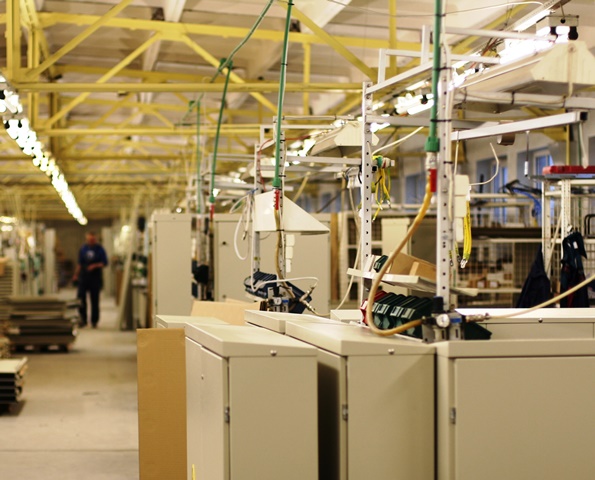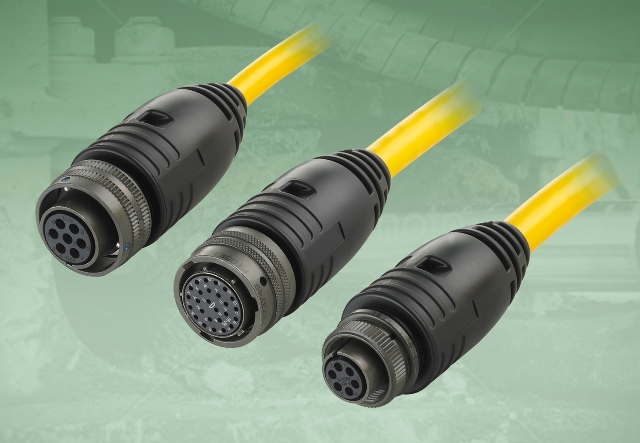Connectivity serves as a cornerstone of industrial automation environments (see Fig.1 ). With the need to monitor, control, and communicate with more devices (such as sensors, safety devices, and PLCs) in a vast range of applications, reliable connectivity solutions are necessary for achieving and maintaining operations.

Fig. 1: Industrial automation environments, such as the one shown here, rely heavily on dependable connectivity for continuous production control, data acquisition, and enterprise-wide communicatio n.
Connectors and cordsets should be a consideration during the initial design process to create a reliable system, save cost, and improve machine efficiency. Knowing an application's connectivity requirements in the beginning will help lessen wiring errors and connection issues later during implementation, as well as aid in determining which cables are best suited for a given task and location. When selecting the proper connectors and cordsets, there are several factors that should be taken into consideration, including the applications and intended use, the necessary components, and the environment in which the cordset will be installed.
Connectivity components
The connector component of the cordset consists of a contact carrier or contact holder with either pins or bushings, based on whether it is a male- or female-type device. In addition to male/female designation, cordsets are also characterized by the number of contacts, orientation, size, contact resistance, insulation between pins, resistance to entry of water or other contaminants, resistance to pressure, reliability, longevity, and ease of connecting and disconnecting.
To minimize connection errors, some cordsets are “keyed,” which means certain mechanical components on the contact holder prevent mating except with a correctly oriented matching cordset. This helps avoid incorrect or damaging interconnections. Further, cordsets can also be specially designed to feature housings, such as threaded-style housing, with locking mechanisms for additional connection security. These designs prevent inadvertent disconnection or poor environmental sealing, providing resistance to water and dust ingress and protection in areas of high impact.
Most cordsets are also engineered to satisfy industry standards, including those set by the International Electrotechnical Commission (IEC), which standardizes the dimensions of the contact carrier within a cordset. With the high volume of connections made in any given application or facility, it is important that cordsets meet specific design factors. For instance, interoperability/inter-mating between cordsets is important, as many manufacturers develop various products that all use the same cordset style. A cordset's features have a direct impact on whether it is selected for an application. For example, an A-Coded M12 cordset type would be used with sensor and actuators, a B-Coded M12 cordset with field buses, and a D-Coded or X-Coded M12 cordset with Industrial Ethernet.
Together, connectors, cordsets, and cables provide a complete connectivity solution, providing secure connections to everything from sensors and control equipment to networking devices. Available in a wide variety of configurations as well as housing styles and materials, these components are designed to deliver a comprehensive, reliable, end-to-end connection solution for virtually any connectivity requirement.
Cordset features and characteristics
Manufacturers are always looking for ways to increase productivity and efficiency to decrease downtime. Using the proper cordset is often a key contributing element of an application's continued operation. These applications are typically subjected to a wide range of environmental conditions, and cordsets need to be able to withstand diverse, punishing elements such as moisture, chemicals, temperature fluctuations, and vibration.
The environment where a cordset will be installed generally determines the type of cordset and cable used. To provide the ideal level of performance, cordsets are available with Ingress Protection (IP) ratings, such as IP67 or IP68, which ensure the solution is designed to prevent contaminants from entering the cordset and diminishing performance. For example, industrial applications with wide, spacious areas may use a larger cordset with a locking mechanism featuring an IP67 sealing gasket system to guard against water and vibration. Alternatively, a more compact IP20 cordset may be used for clean areas or inside control cabinets.
Cordsets are expected to perform in applications that involve everything from welding and high-flex robotics to washdown or hygienic conditions. Cordsets must also withstand shock and vibration, crushing and pulling, bending or twisting, dust and dirt, water, oils, chemicals, corrosive gasses, or temperature extremes. Numerous industrial and process environments require approvals from various agencies like the NEC, FM, UL, or CSA.
Cordsets for wireless systems
With applications moving faster than ever and industries becoming more competitive, maintaining effective control and communication has never been more crucial. One way facilities are achieving this is by using Ethernet protocols to wirelessly connect to the entire system. Ethernet enables networks to extend into hazardous locations or allows operators to include additional monitoring devices onto the network. Though by its very nature, the term “wireless” implies the absence of wires and cords, in order for this technology to operate, there must be a central point of connection or access point.
The wireless access point (WAP) is where the wireless system is connected to the main network. Whether using an in-cabinet I/O solution or distributed I/O technology, cordsets are necessary for overall functionality. Connections need to be made within the WAP to fulfill both the signal and power requirements that allow a wireless a system to operate properly. In industrial environments, signal and power connections within the WAP require the use of rugged industrial connectors and cordsets.
If the cordset is being used in Ethernet applications, additional factors need to be considered, as each Ethernet protocol, such as Modbus TCP/IP and Ethernet/IP, presents multiple differences, requiring cordsets with diverse performance standards and components. Before implementation, operators should analyze network communication signal requirements, including CAT 5e, 6, 6A and 7; two-pair or four pair cabling; D-code or X-code cordsets; solid or stranded cabling; and shielded or unshielded cabling. This will enable users to select an appropriate solution.
Overmolded cordsets
To overcome connectivity challenges with in-the-field assembled cordsets, such as miswiring and moisture ingress, cordsets have progressed to include overmolded options (Fig 2 ).

Fig. 2: An alternative to field-wired products, overmolded cordsets offer are completely encapsulated for increased reliability in harsh environments.
Overmolded connectors are built using an injection molding process that combines two or more materials with a molded plastic component over them to create a single part. Some overmolding is done through a two-step process where the rigid substrate is injection molded first. Next, the substrate is placed in a mold cavity on another injection molding machine where plastic then covers the substrate completely. Since overmolding consolidates materials and parts, it oftentimes eliminates the need for a secondary assembly application.
For cordsets, this mold is placed over the cable and contact holder. This design can provide strain relief and other mechanical advantages. A properly engineered and manufactured molded cable assembly features a fully encapsulated contact and wire termination point. Molded connectors will often have an internal premold, which is part of a molded connector body that provides an essential element to the overall structure of a properly molded cordset assembly.
Overmolded cordsets offer an alternative to field-wired products that deliver a completely encapsulated product. This provides operators with easy-to-use, plug-and-play employability, allowing faster connectivity that enables manufacturers to optimize uptime. With a rugged molded body that reinforces and protects that cordset, connection integrity is enhanced for increased connectivity reliability.
Looking ahead
Cordsets acts as building blocks for virtually any industrial operation and provide a foundational element for creating a wireless network. Understanding their function and importance in networking applications allow facilities to maintain effective communication and data access. Implementation of the proper connectivity products reduces installation time, maintenance, and system downtime, resulting in increased productivity and profitability.
Advertisement
Learn more about Turck





